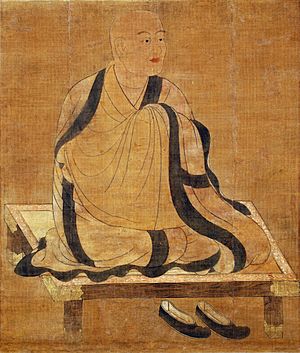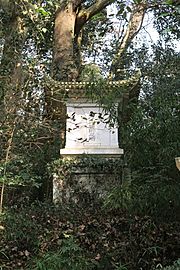Yi Xing facts for kids

Yi Xing (Chinese: 一行; pinyin: Yī Xíng; Wade–Giles: I-Hsing, 683–727), born Zhang Sui (Chinese: 張遂), was a brilliant Chinese astronomer, mathematician, inventor, engineer, philosopher, and Buddhist monk. He lived during the Tang dynasty (618–907). Yi Xing is famous for creating an astronomical celestial globe that used a special clockwork escapement mechanism. This was the first of many amazing Chinese astronomical clocks.
Contents
What did Yi Xing achieve in science and technology?
Mapping the Earth and stars
In the early 700s, the Tang dynasty government asked Yi Xing to lead a huge survey of the land and the sky. This project had several important goals. One goal was to gather new information about the stars and planets. This data would help predict solar eclipses more accurately.
Another purpose was to fix problems with the old calendar system. The survey helped create a new, better calendar. It also helped measure the length of a meridian arc, which is a line of longitude on Earth. Even though Yi Xing didn't know the Earth was round, his measurements were very helpful. This work solved confusion from earlier methods that used sun shadow lengths to guess distances between places.
Yi Xing set up thirteen test sites across the empire. These sites stretched from Jiaozhou in Vietnam (at about 17°N latitude) all the way to the area south of Lake Baikal (at about 50°N latitude). At each site, three observations were made: the height of Polaris (the North Star), and the lengths of shadows in summer and winter.
From this information, the latitudes of the sites were figured out. The Tang dynasty's calculation for the length of one degree of meridian was quite close to what modern science knows today. Yi Xing understood that the length of a degree of meridian could change. He disagreed with older scholars who used a fixed shadow length for the whole year.
The amazing escapement and celestial globe
Yi Xing was known for his incredible intelligence. He even tried to calculate how many possible moves there were in the game of Go.
He is most famous for working with another engineer, Liang Lingzan. Together, they created the earliest known escapement mechanism. This device was used in a water-powered celestial globe. An escapement is a key part of clocks that helps control their movement.
Yi Xing's mechanical inventions were built on the work of earlier Chinese engineers. These included Zhang Heng (78–139) from the Han Dynasty, Ma Jun (200–265) from the Three Kingdoms period, and Li Lan (around 450 AD).
The inventor Zhang Heng was the first to use water power (like a waterwheel and water clock) to move his armillary sphere. This sphere showed the movements of planets and stars. Yi Xing also learned from followers of Ma Jun, who used waterwheels to power mechanical toys. Li Lan was an expert in water clocks, which also inspired Yi Xing.
Like Zhang Heng's earlier water-powered devices and the later astronomical clock tower by Su Song (1020–1101), Yi Xing's celestial globe used water power to spin and work correctly. The historian Joseph Needham wrote about this:
When the first escapement came, in +725 (AD), I-Hsing and Liang Ling-tsan arranged for two jacks to strike the hours, standing on the horizon surface of their sphere or globe.
Later, in 979 AD, Zhang Sixun used liquid mercury instead of water to power an armillary sphere. Mercury wouldn't freeze in winter. A historical text from the Song dynasty (960–1279) explains why Yi Xing's armillary sphere didn't last:
A jade balancing mechanism (ie. the escapement) is erected behind a curtain, holding and resisting the main scoops. Water pours down rotating the wheel. Lower, there is a cog-wheel with 43 teeth. There are also hooks, pins, and interlocking rods one holding another. Each moves the next without reliance on any human force. The fastest wheel turns round each day through 2928 teeth, the slowest one moves by 1 tooth in every 5 days. Such a great difference is there between the speed of the wheels, yet all of them depend on one single driving mechanism. In precision, the engine can be compared with Nature itself. As for the rest, it is much the same as the apparatus made by I-Hsing. But that old design employed mainly bronze and iron, which corroded and rusted so that the machine ceased to be able to move automatically. The modern plan substitutes hard wood for these parts, as beautiful as jade...
Older Tang era texts from the 800s also describe Yi Xing's astronomical instruments from the 700s:
One (of these) was made in the image of the round heavens and on it were shown the lunar mansions in their order, the equator and the degrees of the heavenly circumference. Water, flowing (into scoops), turned a wheel automatically, rotating it (the sphere) one complete revolution in one day and night. Besides this, there were two rings fitted round the celestial (sphere) outside, having the sun and moon threaded on them, and there were made to move in circling orbit. Each day as the celestial (sphere) turned one revolution westwards, the sun made its way one degree eastwards, and the moon 13 and 7/19 degrees (eastwards). After 29 and a fraction rotations (of the celestial sphere) the sun and moon met. After it made 365 rotations the sun accomplished its complete circuit. And they made a wooden casing the surface of which represented the horizon, since the instrument was half sunk in it. This permitted the exact determinations of the times of dawns and dusks, full and new moons, tarrying and hurrying. Moreover there were two wooden jacks standing on the horizon surface, having one a bell and the other a drum in front of it, the bell being struck automatically to indicate the hours, and the drum being beaten automatically to indicate the quarters.
All these motions were brought about (by machinery) within the casing, each depending on wheels and shafts, hooks, pins and interlocking rods, coupling devices and locks checking mutually (ie. the escapement). Since (the clock) showed good agreement with the Tao of Heaven, everyone at that time praised its ingenuity. When it was all completed (in +725) it was called the 'Water-Driven Spherical Bird's-Eye-View Map of the Heavens or 'Celestial Sphere Model Water-Engine' and was set up in front of the Wu Chheng Hall (of the Palace) to be seen by the multitude of officials. Candidates in the imperial examinations (in +730) were asked to write an essay on the new armillary (clock). But not very long afterwards the mechanism of bronze and iron began to corrode and rust, so that the instrument could no longer rotate automatically. It was therefore relegated to the (museum of the) College of All Sages and went out of use.
Yi Xing's Buddhist studies
Yi Xing also wrote important religious texts. He wrote a detailed explanation of the Mahavairocana Tantra, a significant Buddhist scripture. This work greatly influenced the Japanese monk Kūkai. It was very important in helping Kūkai establish Shingon Buddhism in Japan.
Honoring Yi Xing
At the Guoqing Temple in Zhejiang Province, there is a special Chinese pagoda built to honor Monk Yi Xing. This pagoda is located right outside the temple, which is part of the Tiantai-Buddhist tradition on Mount Tiantai. Yi Xing's tomb is also found on Mount Tiantai.
See also
 In Spanish: Yi Xing para niños
In Spanish: Yi Xing para niños


